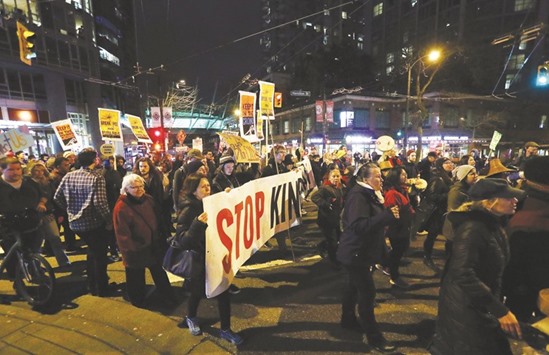Canada on Tuesday approved two new pipelines including one to the Pacific coast that will allow producers to sell into new Asian markets, while rejecting a third project.
Prime minister Justin Trudeau told a press conference his government has agreed to tripling the capacity of Kinder Morgan’s half-century-old Trans Mountain pipeline to move crude from the Alberta oil sands to the Pacific coast, to 890,000 barrels per day.
At the same time, it greenlit another pipeline to the United States, Enbridge’s Line 3.
And it rejected the construction of a new oil conduit to the Pacific that would have crossed a temperate rainforest: Enbridge’s Northern Gateway.
The three projects aimed to get Canada’s abundance of landlocked Alberta oil to new buyers.
They have been decried by environmental activists but supported by the Tory opposition and business groups.
The pair that were approved will add new capacity to move nearly one million barrels of oil to US and overseas markets.
“These two projects are in the national interest,” Trudeau said.
In May, the National Energy Board recommended approving twinning of the 1,150km Trans Mountain project, with 157 conditions.
But the project continued to face stiff opposition at the end of the line over concerns it would significantly increase oil tanker traffic in Vancouver harbour.
In an effort to allay concerns, Trudeau committed Can$1.5bn for marine emergency preparedness, including cleaning up oil spills.
Reactions to the pipeline decisions were acute but mixed.
Trans Mountain’s approval is widely seen as a trade-off for rejecting the more controversial 1,177km Northern Gateway project.
Aboriginals and environmental activists feared a spill from tankers sipping from a terminal connected to the Northern Gateway pipeline could damage the pristine coastline that includes salmon-bearing rivers and the habitat of a rare white bear.
Trudeau himself has expressed opposition to building the pipeline through the world’s largest coastal temperate rain forest.
“The Great Bear Rain Forest is no place for a pipeline and the Douglas Channel is no place for oil tanker traffic,” he said, adding that a tanker moratorium along the northern British Columbia would be made permanent.
Enbrige’s Can$7.3bn Line 3, meanwhile, has generated relatively little opposition.
The new 1,660km pipeline with double the capacity will replace an existing pipeline from Hardisty, Alberta to Superior, Wisconsin. By 2019 it is expected to begin moving 760,000 barrels of oil per day.
Canada is the world’s sixth largest oil producer but its ageing network of pipelines is at capacity and new conduits, says the industry, are desperately needed.
A lot of hope had been placed on the proposed Keystone XL pipeline from Alberta to US Gulf Coast refineries, to unblock the congestion.
But US president Barack Obama’s rejection of the project threw Canada’s energy resources management into disarray, with no new routes to get Alberta’s growing crude supply to markets.
President-elect Donald Trump has said he would reverse the earlier decision and approve Keystone XL.
But Ottawa has shifted focus to diversifying its customer base.
Currently, nearly all of Canada’s oil exports go to the United States.
Trans Mountain and Line 3 are the first major pipeline projects to be approved by the Liberal government since it swept to power in 2015.
This comes after more than a decade of stagnation in pipeline construction.
“The fact is oil sands production is going to increase in the coming years,” Trudeau noted.”Because we are at capacity in terms of existing pipelines, that means more oil is going to be transported by rail in the coming years if we don’t build pipelines.”
The pipeline approvals, he said, were “based on rigorous debate, on science and on evidence.
We have not been and will not be swayed by political arguments.”
Conservative MP Mark Strahl said the Liberals “need to champion (all of) these projects...
They need to stand up for energy workers in Canada”.
Critics, however, lamented the government’s mixed signals — on the one hand approving pipelines that would allow the Alberta oil sands production to soar, while on the other seeking to curb greenhouse gas (GHG) emissions.
Trudeau agreed at the Paris climate talks last year to cut Canada’s GHGs by 30% by 2030.
The government has announced steps to meet its obligation including a phase-out of coal-fired power.
But Canada’s oil sands are the nation’s fastest growing source of GHGs, responsible for 9.3% of its total emissions.

Protesters walk down Robson Street in opposition to Canada’s decision to approve Kinder Morgan Inc’s pipeline


